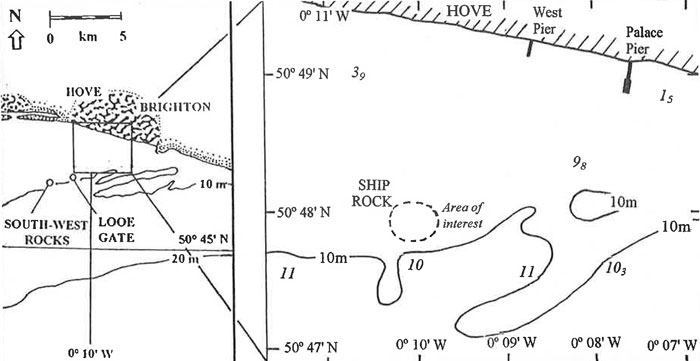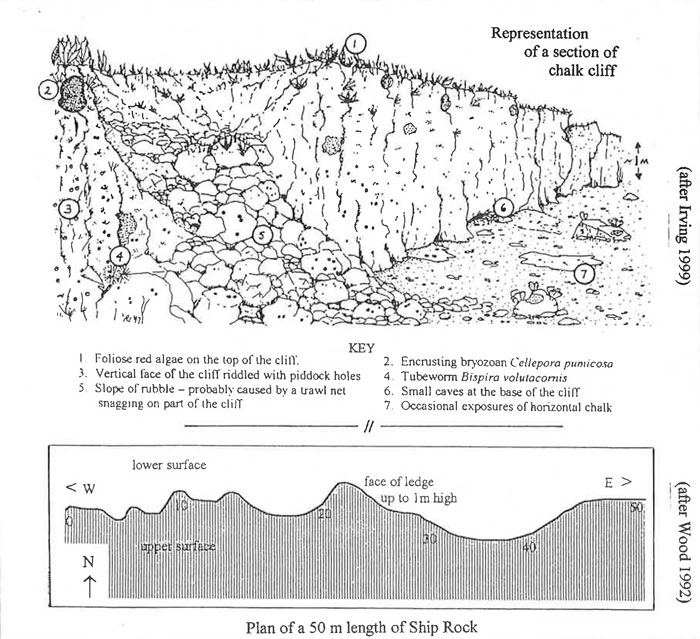SUSSEX MARINE SITES OF NATURE CONSERVATION IMPORTANCE
| Site: Ship Rock | Ref. No. 17 | ||||||
| Location: 2 km SSW of the West Pier, Hove | Other conservation designation?: No |
||||||
| Lat./Long. position of centre of site: 50° 47' 95" N 0° 9' 90" W |
OS grid ref. of centre of site: TQ 293 016 |
Author: Robert Irving |
|||||
| Sea bed type: Low-lying chalk reef/cliff. |
Depth range (below chart datum): 9-11 m |
Date identified: June 2001 |
|||||
Summary
Ship Rock is a sublittoral exposure of low-lying chalk cliff (or ledge) approximately 2 km SSW of the West Pier, Hove. The cliff lies at a depth of 9-11 m BCD and is reported to be just over 100 m long. The maximum height of the cliff is 1.0 m (along two short sections), though it has an average height of nearer 0.5 m. It is assumed this is the same site known by some divers as Kingswest Ledge. Indeed, this may be a more appropriate name for the whole linear feature. It is reported that sections of the cliff appear to have collapsed, possibly the result of fishing gear being towed over them.
Biological Description
As with the other sections of sublittoral chalk cliffs present off Sussex, the line of the cliff forming Ship Rock runs approximately WSW/ENE. The cliff face itself faces the shore (i.e. northwards), the top of the cliff being on the seaward (though shallower) side.
The cliff is roughly stepped for much of its length, with many fissures, crevices and holes. Many of the exposed sheltered surfaces are heavily silted. The cliff's horizontal top has sparse foliose red algae growing on it, with occasional clumps of hydroids on the current-swept edge. The vertical chalk faces have a general covering of hydroid-bryozoan turf and are frequently riddled by piddock holes (most likely to be Pholas dactylus). Other fauna, such as colonial ascidians (e.g. Aplidium punctum), sponges and erect bryozoans cover the chalk surface. Occasional clusters of Bispira volutacornis tubeworms are present in places. The base of the cliff has been eroded in places to form small caves, often occupied by crustacea, especially prawns and edible crabs Cancer pagurus. Other mobile fauna present include occasional velvet swimming crabs Necora puber, goldsinny Ctenolabrus rupestris, ballan wrasse Labrus bergylta, tompot blennies Parablennius gattorugine, and leopard-spotted gobies Thorogobius ephippiatus. Triggerfish Balistes carolinensis have also been recorded from this vicinity and seen sheltering within the small caves. At the foot of the cliff, horizontal exposed chalk bedrock is present, with scattered chalk boulders, cobbles and mixed sediments.
Justification
Sussex is the only location in the British Isles where chalk strata appear as offshore, linear 'cliffs' (i.e. vertical faces between 1-4 m in height). These exposures are therefore of regional, if not national, importance, more as an unusual feature rather than on account of the marine communities they possess. Other sublittoral chalk cliff exposures off Sussex include the Worthing Lumps (mSNCI ref. 8), SouthÂWest Rocks (mSNCI ref. 9) and Looe Gate (mSNCl ref. 10).
References:Irving, R. A. 1998. Sussex Marine Life - an identification guide for divers East Sussex Council, Lewes |
|||||||
| Sussex SEASEARCH dive nos.: 713/49-51, 168-170, 185-187 & 202 | |||||||
| Sussex Sublittoral Survey site no.: 83/30 | |||||||
Site Location

Diagrammatic representation of site: Ship Rock


:Link to this page
Copyright Sussex Biodiversity Records Centre © 2025